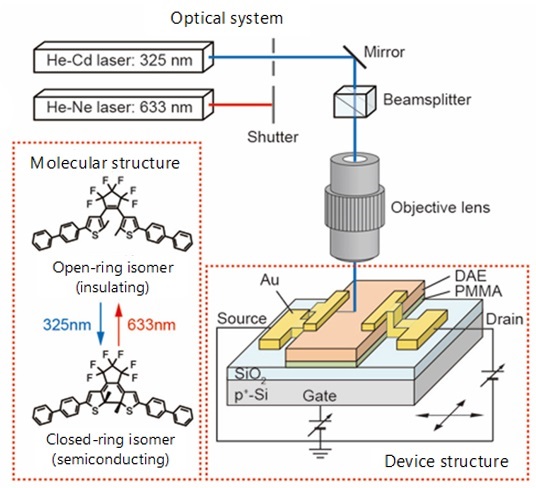2017.02.21
For the first time in the world, a NIMS–Kyoto University joint research group succeeded in drawing transistor circuits and other devices on thin films of photoisomers, by irradiating light onto the films.
(“Laser Patterning of Optically Reconfigurable Transistor Channels in a Photochromic Diarylethene Layer”; Tohru Tsuruoka, Ryoma Hayakawa, Kazuyoshi Kobashi, Kenji Higashiguchi, Kenji Matsuda, and Yutaka Wakayama; Nano Lett., 2016, 16 (12), pp 7474–7480 DOI: 10.1021/acs.nanolett.6b03162)
For the first time in the world, a joint research group consisting of Tohru Tsuruoka, principal researcher, Ryoma Hayakawa, senior researcher, and Yutaka Wakayama, leader of the Quantum Device Engineering Group, MANA, NIMS, as well as professor Kenji Matsuda and assistant professor Kenji Higashiguchi, Graduate School of Engineering, Kyoto University, succeeded in drawing transistor circuits and other devices on thin films of photoisomers, by irradiating light onto the films. These molecules can switch back and forth between one type of isomers that act like insulators and another type of isomers that act like semiconductors when they are exposed to light. These molecular properties enabled circuit rewriting and electric current control. These findings may also be applicable to fabrication of logical operation devices.
Photoisomerization is a change in molecular structure and electronic state as molecules are exposed to visible or ultraviolet light. The altered state of molecules after undergoing photoisomerization can be reversed into the original state by irradiating them with light of certain wavelengths. In light of this property, it was suggested a long time ago that these molecules can be applied to memory and sensor devices. In recent years, vigorous efforts were made in the development of transistor elements that respond to light, by adding photoisomers to organic transistors. However, because only trace amounts of photoisomers were added in these studies, the increase in electric current value due to photoinduction was limited to about a factor of two. In other studies, a technology to fabricate organic transistors is being developed with the approach of printing devices on flexible substrates. This method had issues in terms of miniaturization of devices and circuit design as organic molecules break easily using conventional techniques.
This research group previously succeeded in controlling more than 1,000 times greater electric current values than conventional values by directly using photoisomers as a transistor channel layer. This success was attributed to the discovery of a new material that possesses both photoisomeric and semiconducting properties and the discovery of the fact that the material can act as a semiconductor and insulator alternately by applying light to it. In this joint research, the group further advanced these findings by drawing transistor circuits on a thin film of photoisomers that are in an insulating state. Specifically, the group irradiated a very narrow light beam onto a certain part of the thin film, and thereby converted that part into a semiconductor.
The joint research group developed a novel setup, which made it possible to scan the UV and visible spotlights precisely at same locations. This technique enabled us to design electric circuits those are a multiple one-dimensional channels connected in parallel, optical valves to turn on/off electric current, and Y-shaped transistor channels. These elemental techniques were achieved by utilizing the unique property of the photochromic molecule, that is, the phase transition between semiconductor and insulator can be induced by alternate UV-Vis light irradiation. Based on this technique, the group succeeded in fabrication of adder circuits capable to control electric current by adjusting the strength of light irradiation and location of optical valves.
The findings in this study not only will serve as a new method to fabricate organic transistors but also may be applied to miniaturization of devices and large scale integration that had been major challenges in the field of organic electronics. The technology also may be applicable to optical drawing of logical circuits.
This work was supported by JSPS KAKENHI Grant Number JP15H01098 in Scientific Research on Innovative Areas “Photosynergetics”. The study was published in the online version of Nano Letters, a journal issued by the American Chemical Society, on November 15, 2016.















